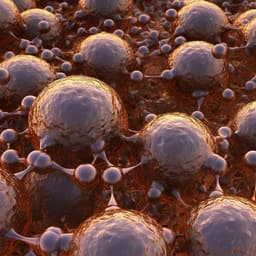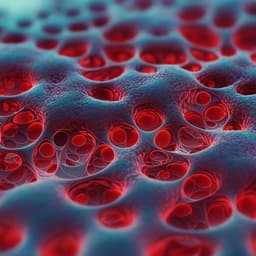
Engineering and Technology
Gallium Oxide Nanowires for UV Detection with Enhanced Growth and Material Properties
B. Alhalaili, R. J. Bunk, et al.
Discover a groundbreaking approach to growing high-density gallium oxide nanowires at elevated temperatures, promising advancements in UV detection technology. This innovative research was conducted by Badriyah Alhalaili and her team.
~3 min • Beginner • English
Introduction
Ultra-wide bandgap β-Ga₂O₃ combines chemical stability and a wide band gap, enabling visible-blind UV sensing and operation in harsh environments for applications such as solar UV monitoring, communications, astronomy, and missile detection. UV photodetectors are sought that operate reliably under extreme conditions while remaining blind to visible light. Nanowires (NWs) offer advantages over thin films, including high surface area, enhanced internal scattering, high photoconductive gain, and reduced effects of lattice/thermal mismatch, aiding high-performance device fabrication. Metal nanoparticles on NW surfaces can induce localized surface plasmons and enhance Rayleigh scattering, improving light absorption and photosensitivity; NW PDs can also decouple absorption and transport paths. The study aims to demonstrate a simple, inexpensive thermal oxidation process to grow high-density β-Ga₂O₃ NWs and to evaluate their structural, optical, and electrical properties for deep-UV photodetection, with particular emphasis on the role of a thin Ag catalyst in growth and device performance.
Literature Review
Prior work has reported β-Ga₂O₃ NW photodetectors with varying catalysts and growth methods, yielding bandgaps in the ~4.3–4.8 eV range (e.g., Ni: 4.30 eV; Au: 4.56–4.8 eV). NW-based PDs commonly achieve high responsivity due to surface effects and internal gain, and plasmonic metals can enhance light-matter interaction. Reported β-Ga₂O₃ UV PDs include nanowire networks grown by CVD with high sensitivity and ultrafast response, and MOCVD MSM devices. Comparative performance data indicate photo-to-dark current ratios ranging from ~4.7 (MOCVD MSM) to ~50 (NW network at 10 V). Literature also discusses growth mechanisms via Ga suboxide (Ga₂O) vapor and the influence of surface oxygen trap states on photoconduction dynamics. Plasmonic Ag nanoparticles can produce hot carriers via interband transitions (<320 nm), potentially boosting UV detection.
Methodology
Quartz substrates (500 µm thick, 15 mm diameter) were solvent-cleaned (acetone, isopropyl alcohol), rinsed with deionized water, and N₂-dried. A 5 nm Ag thin film was sputtered (Lesker) on selected substrates; Ag-free controls received identical cleaning. Immediately prior to growth, samples were re-cleaned and loaded into a quartz crucible positioned in an MTI OTF-1200X-50-SL horizontal alumina tube furnace. A pool of liquid Ga was placed below the substrates, with the Ag-coated surface facing the Ga and a ~10 mm gap. Growth was performed at 800 °C or 1000 °C for 60 min under 20 sccm N₂ at atmospheric pressure with a background O₂ concentration of 100–200 ppm (measured downstream). Ag-coated and uncoated samples were processed in separate runs with dedicated crucibles to minimize cross contamination. Post-growth, electrical contacts were formed by shadow-mask sputtering of 5 nm Cr / 50 nm Au (Lesker) onto the NW surface, or by mechanically applying a 10 × 10 mm Au mesh (0.064 mm thick) as external contacts to avoid sputter-induced damage. Structural characterization included SEM, XRD (Panalytical XPert PRO), SIMS depth profiling (aggregate NW forest), STEM/HAADF and HRTEM (JEOL 2100F) with EDS mapping, and SAED with simulations (CrystalMaker SingleCrystal) for zone axis identification. Optical measurements (transmission/reflection/absorption) were acquired with a UV–VIS spectrophotometer (Ocean Optics HR4000CG-UV-NIR), and bandgaps determined from Tauc plots of (αhv)² vs photon energy. Electrical measurements employed a custom probe station with a Keithley 2400 SMU. Illumination used a Dymax Bluewave75 broadband UV lamp (280–450 nm), LED sources at 250/260/280 nm (1 mW), and a XeHg lamp with a monochromator for responsivity spectra. MSM Au/β-Ga₂O₃/Au photoconductors were tested for I–V in dark and under UV, photocurrent/dark current ratios, responsivity vs wavelength, and transient responses (shuttered illumination).
Key Findings
- Ag catalyst enhanced Ga₂O₃ NW growth at 1000 °C, producing denser, longer, and thinner NWs compared to Ag-free growth. SEM showed diameter reduction from ~150–270 nm (no Ag) to ~120–160 nm (with 5 nm Ag).
- XRD confirmed polycrystalline β-Ga₂O₃ (JCPDS 11-370) for both cases; differences in relative (020)/(002) intensities were observed between Ag and no-Ag samples.
- Optical bandgap from Tauc analysis: 4.6 eV (no Ag) and 4.4 eV (with Ag), consistent with prior reports and indicating a ~0.2 eV shift with Ag decoration.
- SIMS depth profiles indicated nonuniform Ag distribution within the NW forest and an increasing Ag/Ga signal ratio towards the quartz substrate (NW base).
- STEM/HAADF and HRTEM revealed Ag nanoparticles decorating the NW surface in Ag-assisted samples (2–10 nm), not visible by SEM; Ag was detected by EDS mapping though individual NPs could be below EDS sensitivity.
- SAED patterns showed single-crystalline NWs with growth direction along [-110] and orthogonal [001] for both Ag and no-Ag, indicating Ag does not alter NW orientation; no twins or secondary Ga₂O₃ phases were observed.
- Electrical I–V: With sputtered Au contacts, Ag-decorated NWs exhibited photocurrents up to three orders of magnitude higher than Ag-free NWs under UV (broadband, ~15 W/cm²), but also higher dark current, attributed to sputter-induced interfacial damage and possible Ag–Au interaction. Using Au mesh contacts reduced dark current and improved performance; with mesh contacts, Ag NPs decreased dark current while increasing photocurrent.
- Photocurrent-to-dark current ratio at 10 V: 4.55 (no Ag) vs 38.3 (with 5 nm Ag). Under selected UV wavelengths (250, 260, 280 nm), Ag samples showed ~two orders of magnitude improvement in photodetection response.
- Responsivity: Ag-coated devices exhibited ~1.5 orders of magnitude higher responsivity across a broad range; below 300 nm, Ag samples were ~3–5× larger than no-Ag near 260 nm. Solar-UV rejection ratio (R320 nm/R260 nm) ~50 (Ag) vs ~100 (no Ag).
- Transient response: Rise time (10–90%) improved from 1.12 s (no Ag) to 0.33 s (with Ag); fall time similar (2.0 s vs 2.2 s). Ag plasmonic effects and surface band-bending facilitate faster turn-on.
- Mechanism: Growth proceeds via oxidation of Ga to Ga₂O₃, reduction to Ga₂O vapor by liquid Ga, transport and re-oxidation to Ga₂O₃ (VLS-like). Ag enhances oxygen availability (high O₂ solubility in Ag, dewetting-induced NP formation), boosting Ga₂O₃ nucleation and NW growth. In devices, Ag forms localized Schottky barriers (ΦB ≈ 0.26 eV) that reduce dark current, while interband transitions (<320 nm) generate hot electrons that surmount the barrier, enhancing photocurrent.
Discussion
The work demonstrates that a simple thermal oxidation route in trace oxygen can produce high-density β-Ga₂O₃ nanowires suitable for deep-UV photodetection, and that a thin Ag catalyst significantly improves both growth kinetics and device performance. Structurally, Ag increases NW density and reduces diameter without changing crystallographic growth direction, consistent with a VLS-like mechanism mediated by Ga₂O vapor and enhanced by Ag’s oxygen uptake and Ag–Ga–O interfacial chemistry. Optically, Ag decoration reduces the apparent bandgap by ~0.2 eV, consistent with literature on Ag/Ga₂O₃ interactions. Electrically, Ag nanoparticles at the NW surface create localized Schottky barriers that deplete carriers in the dark, lowering dark current (especially with non-damaging mesh contacts), while plasmonic and interband transitions in Ag under sub-320 nm light generate hot electrons that inject into Ga₂O₃, increasing photocurrent and responsivity. The resulting devices achieve an order-of-magnitude improvement in photo/dark ratios and faster rise times. Although some solar-range response remains (rejection ratio ~50 with Ag), the devices exhibit strong deep-UV sensitivity around 260 nm. These findings validate the hypothesis that Ag catalysis and decoration can be leveraged both to enhance NW growth and to engineer favorable optoelectronic interfaces for UV photodetection.
Conclusion
A β-Ga₂O₃ nanowire UV photodetector grown by thermal oxidation was demonstrated with and without a 5 nm Ag catalyst. Ag plays a critical role in enhancing NW growth via its high oxygen solubility and diffusivity, without altering NW crystallographic orientation. Ag-decorated devices achieved substantially improved performance, including higher photocurrents, increased responsivity (~1.5 orders of magnitude), improved photo-to-dark current ratio (38.3 vs 4.55 at 10 V), and faster rise times (0.33 s vs 1.12 s). The responsivity exhibits a cutoff near 320 nm, consistent with mid-gap states and Ag interband effects. The simple, scalable fabrication suggests promise for mass production of UV sensors with high sensitivity and spectral selectivity. Future work could target optimizing contact strategies to minimize damage, further enhancing solar blindness, detailed single-NW compositional profiling, and stability/reliability studies under harsh environments.
Limitations
- SIMS depth profiling could not be performed on individual nanowires due to instrument spot size; results represent an aggregate of randomly oriented NWs.
- SEM did not reveal Ag nanoparticles; their small size (2–10 nm) required STEM/HRTEM for confirmation, and EDS sensitivity/interaction volume limited direct detection of very small Ag NPs.
- Sputtered Au contacts induced interfacial damage (e.g., disorder, vacancies) leading to increased dark current and Fermi level pinning; performance depended strongly on contact method, necessitating Au mesh to reduce artifacts.
- Significant responsivity persists above 300 nm, yielding a lower solar-UV rejection ratio (~50 with Ag) compared to Ag-free (~100), indicating incomplete solar blindness.
- Transfer techniques for TEM made it difficult to identify NW tip vs base in some images, complicating spatial assignment of features.
Related Publications
Explore these studies to deepen your understanding of the subject.







